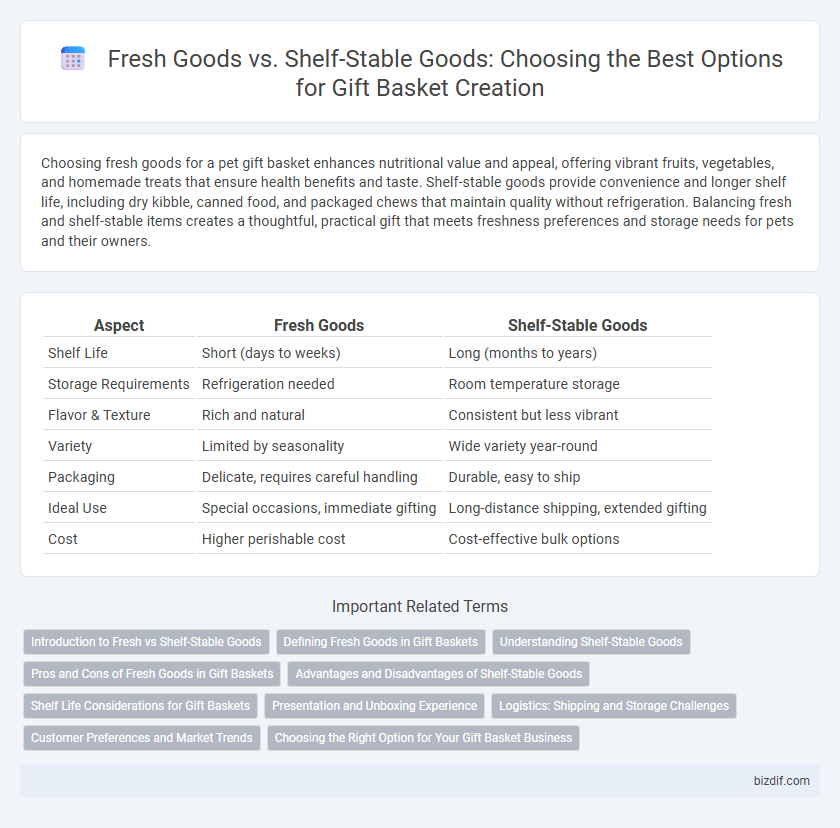Choosing fresh goods for a pet gift basket enhances nutritional value and appeal, offering vibrant fruits, vegetables, and homemade treats that ensure health benefits and taste. Shelf-stable goods provide convenience and longer shelf life, including dry kibble, canned food, and packaged chews that maintain quality without refrigeration. Balancing fresh and shelf-stable items creates a thoughtful, practical gift that meets freshness preferences and storage needs for pets and their owners.
Table of Comparison
| Aspect | Fresh Goods | Shelf-Stable Goods |
|---|---|---|
| Shelf Life | Short (days to weeks) | Long (months to years) |
| Storage Requirements | Refrigeration needed | Room temperature storage |
| Flavor & Texture | Rich and natural | Consistent but less vibrant |
| Variety | Limited by seasonality | Wide variety year-round |
| Packaging | Delicate, requires careful handling | Durable, easy to ship |
| Ideal Use | Special occasions, immediate gifting | Long-distance shipping, extended gifting |
| Cost | Higher perishable cost | Cost-effective bulk options |
Introduction to Fresh vs Shelf-Stable Goods
Fresh goods in gift baskets, such as fruits, cheeses, and baked items, offer vibrant flavors and appealing textures but require careful handling and timely delivery to maintain quality. Shelf-stable goods, including nuts, chocolates, and dried fruits, provide longer-lasting freshness and convenience without refrigeration, making them ideal for extended shipping or storage. Selecting between fresh and shelf-stable products significantly impacts the basket's appeal, logistics, and shelf life considerations.
Defining Fresh Goods in Gift Baskets
Fresh goods in gift baskets consist of perishable items such as fruits, cheeses, baked goods, and gourmet chocolates that require refrigeration or prompt consumption to maintain quality. These items are prized for their vibrant flavors and premium appeal, often sourced locally to ensure peak freshness and support artisanal producers. Incorporating fresh goods enhances the sensory experience and perceived value of gift baskets, distinguishing them from those containing only shelf-stable products.
Understanding Shelf-Stable Goods
Shelf-stable goods are food products designed to remain safe and edible without refrigeration for extended periods, achieved through processes like dehydration, canning, or vacuum sealing. These items, including canned fruits, nuts, and dried snacks, are ideal for gift baskets as they offer convenience, longer shelf life, and reduced risk of spoilage during shipping. Incorporating shelf-stable goods enhances the basket's versatility, ensuring recipients can enjoy the gift at their own pace without worrying about freshness.
Pros and Cons of Fresh Goods in Gift Baskets
Fresh goods in gift baskets offer vibrant colors, appealing aromas, and superior taste, enhancing the overall sensory experience for recipients. However, their limited shelf life and susceptibility to spoilage require careful handling, swift delivery, and refrigeration, which can increase costs and complicate logistics. Despite these challenges, fresh items like fruits, cheeses, and baked goods convey a sense of luxury and personalization that often outweighs the disadvantages in high-end gifting.
Advantages and Disadvantages of Shelf-Stable Goods
Shelf-stable goods offer the advantage of longer shelf life and easier storage, making them ideal for gift baskets intended to last several weeks without refrigeration. These items include canned fruits, nuts, dried foods, and vacuum-sealed snacks, which maintain quality without the need for immediate consumption. However, shelf-stable goods can lack the fresh flavor and nutritional benefits found in fresh goods, potentially reducing the perceived value of the gift basket for recipients seeking freshness and premium quality.
Shelf Life Considerations for Gift Baskets
Shelf-stable goods offer significant advantages for gift baskets due to their extended shelf life, reducing the risk of spoilage during shipping and storage. Items like gourmet nuts, dried fruits, and specialty jams maintain optimal quality for months, making them ideal for long-distance delivery. Fresh goods, while appealing for immediate consumption, require careful timing and refrigeration to prevent perishability, limiting their suitability for gift baskets intended to last beyond a few days.
Presentation and Unboxing Experience
Fresh goods in gift baskets offer vibrant colors, enticing aromas, and a tactile freshness that enhances the unboxing experience, creating an immediate sensory delight. Shelf-stable goods contribute to a polished presentation with uniform packaging and long-lasting visual appeal, ensuring the basket remains attractive over time. Combining fresh and shelf-stable items elevates both the visual impact and sustained enjoyment, making the gift basket memorable from first glance to consumption.
Logistics: Shipping and Storage Challenges
Fresh goods in gift baskets require strict temperature control and expedited shipping to maintain quality, increasing logistics complexity and costs. Shelf-stable goods offer longer storage life and simplified shipping without refrigeration, easing inventory management and reducing spoilage risks. Balancing these factors is crucial for efficient gift basket logistics and customer satisfaction.
Customer Preferences and Market Trends
Customer preferences in gift basket creation increasingly favor fresh goods like artisanal cheeses, seasonal fruits, and gourmet baked items due to their perceived quality and customization appeal. Market trends reveal a growing demand for shelf-stable goods such as premium nuts, chocolates, and specialty preserves, driven by convenience and longer shelf life. Balancing fresh and shelf-stable products optimizes customer satisfaction and expands market reach in the competitive gift basket industry.
Choosing the Right Option for Your Gift Basket Business
Selecting fresh goods like fruits, baked items, and gourmet cheeses offers a premium appeal and enhances customer satisfaction through vibrant flavor and quality. Shelf-stable goods such as nuts, chocolates, and preserves provide longer shelf life, easier storage, and lower shipping risks, making them ideal for widespread distribution. Balancing both types based on target market preferences and logistics capabilities maximizes profitability and maintains product integrity in your gift basket business.
Fresh goods vs shelf-stable goods Infographic

 bizdif.com
bizdif.com